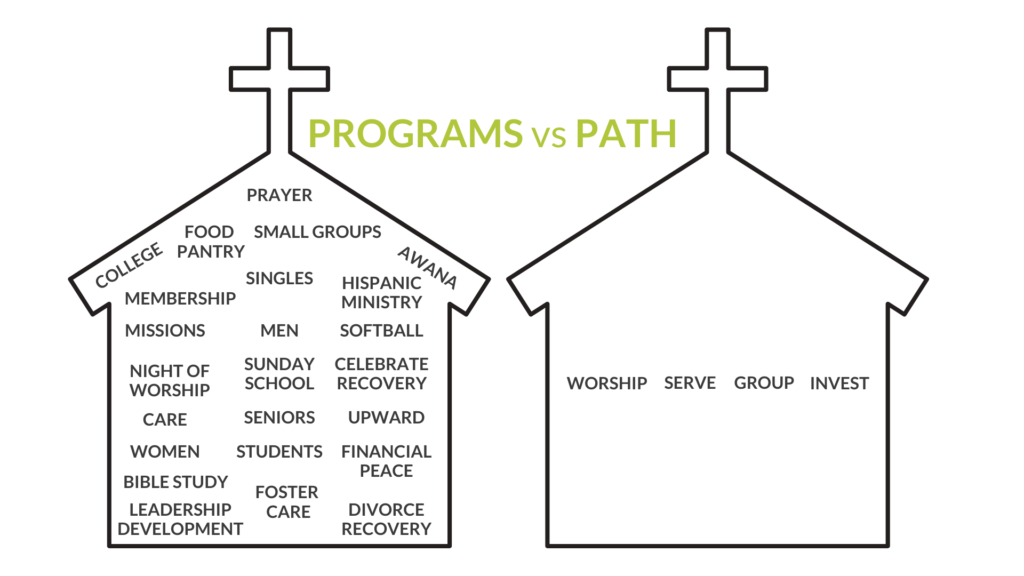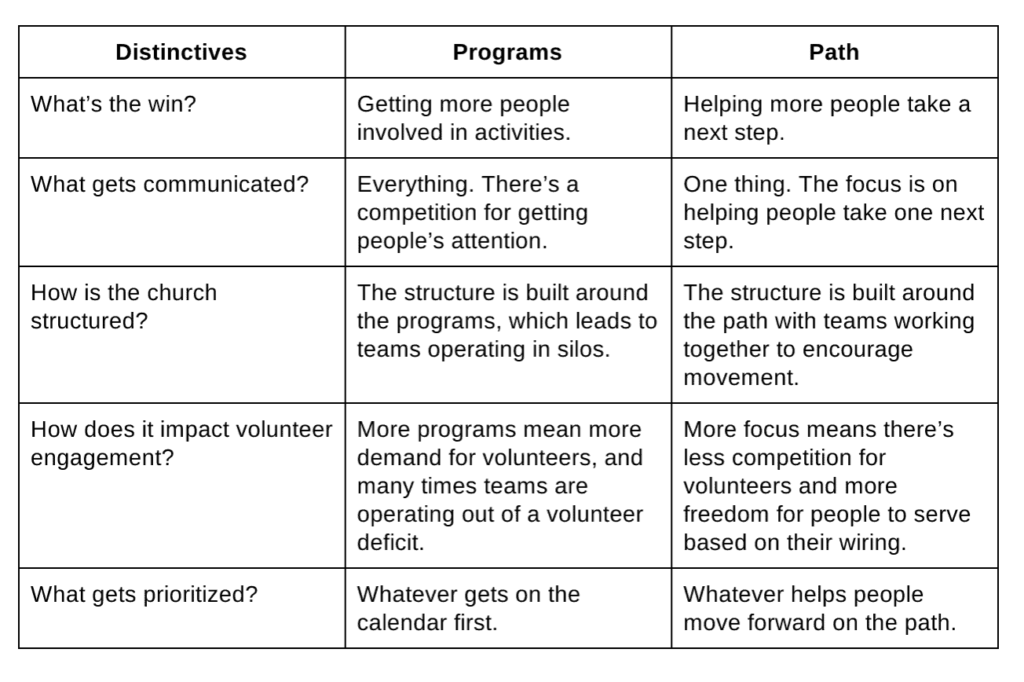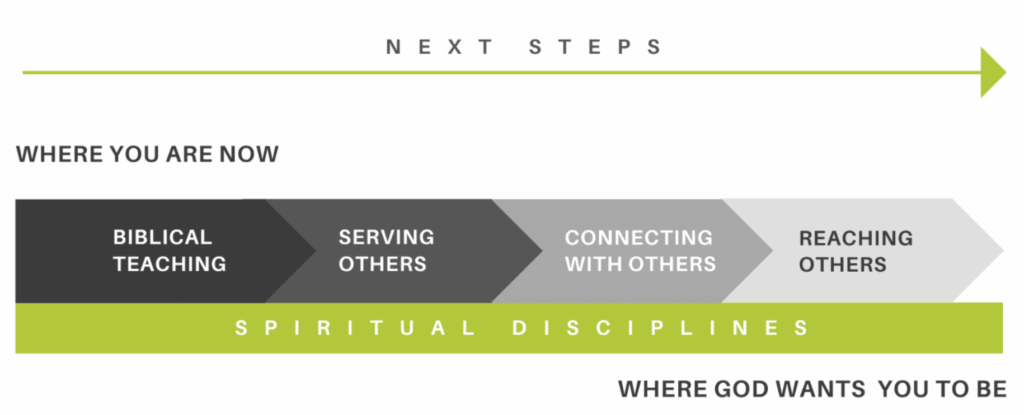The goal of ministry isn’t to keep people busy in church activities—the goal is to equip people to become more like Christ and live out their purpose as part of the body of Christ.
Our natural tendency is to think we need to offer more ministries and more programs to encourage more steps of spiritual formation, but that is faulty thinking:
Over 500,000 church attenders from more than 2,000 churches participated in the Reveal survey, which gives us a clearer picture of how people take steps toward Christ. The data specifically found: “Increased church activity does not lead to spiritual growth.”
Greg Hawkins and Cally Parkinson wrote about the learnings from this research in the book, “Move: What 1,000 Churches Reveal About Spiritual Growth:”
“Unfortunately, churches often make things harder by obscuring the goal—to become more like Christ—with a complicated assortment of activities… When the church incessantly promotes all the things people should do, it’s very easy for them to lose sight of the real goal—which is who they should become.”
The Key to Ineffective Discipleship: Programs
While churches should be in the disciple-making business, they often have no intentional discipleship strategy. Instead, churches tend to opt for a program-driven model that simply ends up keeping their people busy in church activities.
When churches take this program-driven approach, it creates several challenges:
- Ministries within a church start competing with each other for people’s time and attention.
- It feeds a consumer-mindset where the church promotes programs and events for people to attend rather than equipping people to do God’s work.
- Churches continue to add programs as the church grows, creating additional complexity.
- Competing messages about a growing menu of ministry programs make it challenging for people to know their next step.
- Building teams around competing programs makes it difficult to find volunteers for the core ministries of the church.
The solution to this challenge is to move from programs to a path. But defining a clear discipleship path is only half the battle. That path will never gain traction unless you also begin to eliminate some of those competing programs.

If you try to keep all those programs and then communicate your path at the same time, you will only be adding to the noise. It takes leadership to prioritize what’s most important to God even when it may not be the most popular with God’s people. We actually see this principle in the Bible. It’s called pruning.
More Resources:
- Blog: Programs, Paths and Healthy Church Growth
- Blog: Programs Do Not Reach People
- Podcast: The Discipleship Funnel of Doom
- Podcast: 10 Things Unstuck Churches Do Right (Part 2) – Episode 117
Pruning: Overcoming Complexity
There are several reasons that churches drift into complexity and become overprogrammed:
1) Churches don’t have a strategy.
Without a clearly defined strategy, churches naturally gravitate back to what they’ve always done but add on new programs to try to accomplish the new vision. With every iteration of the vision, more things get added, but nothing ever gets subtracted.
2) Churches tend to become insider-focused over time.
It’s completely understandable. Insiders pay the bills. And for fear of making those insiders unhappy, churches tend to hold onto ministry programs even if those programs are not producing health and reaching more people.
3) It’s easier for a church to add a program than it is to redefine its strategy.
A strategic approach means defining who you are trying to reach and then orienting your whole strategy around that focus. That takes work. It will require change. It may offend some church goers. And that’s why most churches take the easy way out and just launch new programs.
4) Churches without a unified strategy develop ministry silos.
Each ministry is part of the same church, but every ministry is separate. Over time, these ministries start competing with each other for space, money, leadership and volunteers. The primary way ministries compete with each other, though, is for people’s attention.
The only solution for combatting complexity is pruning:
“He cuts off every branch of mine that doesn’t produce fruit, and he prunes the branches that do bear fruit so they will produce even more.”
(John 15:2, NLT)
We can learn a few things about good pruning practices from this verse:
1) Pruning is intentional. “He cuts…” Periodically you have to intentionally cut off branches. Initially, the size of the plant is reduced, but it’s because the gardener has intentionally cut back the plant.
2) Both unhealthy and healthy branches are cut back. For the pruning to be effective, we have to cut back the dead and unhealthy branches, but we also must cut back the good things that might prevent us from experiencing the most fruit.
3) It eventually produces more fruit. Every healthy organization knows the power of pruning or getting focused in the short-run to produce long-term results. Be encouraged. If you prune the right way, it will produce more fruit in the future.
- Blog: Complexity: What Ministry Programs Do We Stop?
- Blog: Complexity: How to Bury a Ministry Program
When you determine what programs need to be pruned, don’t delay. Lead strong. Lead well. Involve the key stakeholders early. Connect the decision to your mission and vision for the future. Explain why the pruning is necessary. Celebrate the impact that particular program has had in people’s lives. Celebrate the people who led that ministry program. Tell stories. Then engage those same people in the new spiritual path you’re developing.
More Resources:
- Podcast: Pruning! 3 Ministry Areas to Tackle
- Blog: Pruning: Biblical Practices that Healthy Businesses Embrace and Stuck Churches Avoid
- Blog/Video: How Northbrook Church Cut Programs and Saw Small Groups Thrive
Defining a Simple, Effective Discipleship Path
The advantage in having a simple, clear discipleship path over an assortment of programs is that you make it easy for new followers of Jesus to build important relationships at the right times in their journey. You give them space to ask their questions and opportunities to exercise their faith. You also make it simpler for church leaders and lead volunteers to not let people fall through the cracks, especially early on when they need the most guidance and time investment.
The path may be different from church to church, but essentially you need to identify how you are going to encourage people to take their next steps toward Christ. Then, as a ministry team, you need to pull together to help people experience movement on that path. In other words, the win shifts from attendance at programs to movement on the path.

Everyone is on a personal spiritual journey. So discipleship is all about helping people take their next step.
In the past, as we consulted with churches, we used to leave those steps open for the churches to decide based on the specifics of their ministry and community. But as time has passed, we’ve found some common key next-steps that work well among churches:

Establishing a clear Discipleship Path is all about helping people move from where they are now to where God wants them to be. Everyone has a next-step they can take:
A person new to faith may need to concentrate on biblical teaching and spiritual disciplines. A more mature Christian may need to take steps toward reaching those outside of the faith.
Each step on the Discipleship Path must have an easy to access on-ramp. And there should be in-person and digital opportunities to take each step.
Your discipleship path should be, and will be most effective, if it’s aligned with the 5 stages of a person’s spiritual journey.
Everyone’s spiritual journey is unique . . . sort of. The specific details of how we first encounter Jesus, wrestle with the idea of grace, and accept our need for a Savior are singular. We all have a personal set of people, places, and events that moved us step-by-step toward a relationship with God. But we also have a lot in common.
Most of us pass through 5 stages on our spiritual journey:

You need a ministry strategy for each of these stages (both in person and digital).
Here’s why the 5 stages of a person’s spiritual journey matter to church strategy:
Even though our spiritual journeys don’t begin when we put our trust in Jesus, most churches act like they do.
Most churches spend the majority of their time and resources investing in moving people across the line of faith and then discipling them once they’ve become believers.
Those are important things for any church to do. But if we’re going to embrace both types of engagement, we have to come up with strategies that meet people—insiders and outsiders—where they are. And that means having a plan for stirring interest in the uninterested and walking alongside the spiritually curious while they explore.
- Blog: The First Steps Are Critical on Your Discipleship Path
- Blog: Measuring Discipleship: 6 Signs of Spiritual Growth
- Blog: 5 Questions for a Better Discipleship Path
- Blog: Why Your Discipleship Path is More Important Than Ever
Next Steps for Developing a Discipleship Path
- With your team, discuss some church programs or ministries that may only be keeping people busy in church activities. Which of these need to be pruned in order to create a clear path that helps people take their next steps toward Christ?
- Connect with your team to each identify the top five things God has used to grow your faith. How can this information help you create a clear path that moves people from where they are to where God wants them to be?
We help pastors clarify where God is calling your church to go in the future and define how you'll get there—and then we coach you as you lead change.








Leave a Reply